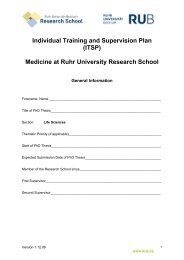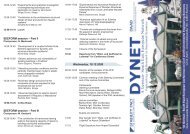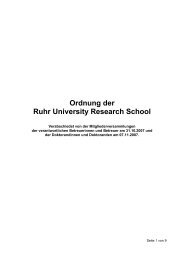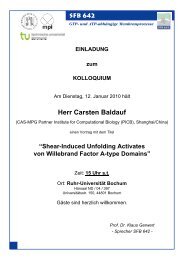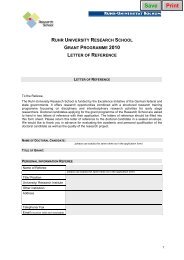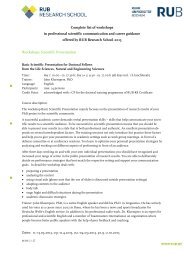Section Days abstract book 2010.indd - RUB Research School ...
Section Days abstract book 2010.indd - RUB Research School ...
Section Days abstract book 2010.indd - RUB Research School ...
Create successful ePaper yourself
Turn your PDF publications into a flip-book with our unique Google optimized e-Paper software.
NSE_26<br />
LOW TEMPERATURE H2O-ASSISTED ALD OF<br />
CRYSTALLINE Gd2O3 THIN FILMS<br />
Ke Xu, Andrian P. Milanov, Harish Parala, Apurba Laha, Ranjith Ramadurai,<br />
Eberhard Bugiel, H. Jörg Osten, Roland A. Fischer and Anjana Devi<br />
Inorganic Materials Chemistry Group<br />
Ruhr-University Bochum, 44780, Bochum, Germany<br />
email: cocoxuke@hotmail.de<br />
In this work, the water-assisted ALD growth of Gd2O3 thin films using the homoleptic<br />
gadolinium guanidinate precursor [Gd{( i PrN)2CNMe2}3] 1 , referred to as [Gd(DPDMG)3] is<br />
investigated. With this precursor, surface controlled, self-limiting ALD-type growth with a<br />
growth rate of ~ 1.1 Å/cycle was observed within a broad temperature window of 175 –<br />
275°C on Si(100) substrates (Fig.1a). The self-limiting character of the film growth was also<br />
verified (Figure 1b). The as-deposited Gd2O3 films were polycrystalline as revealed by<br />
HRTEM and XRD analysis.<br />
Figure 1. Gd2O3 growth rate as a function of (a) the deposition temperature and (b) the [Gd(DPDMG) 3] pulse<br />
time. Inset: dependence of the Gd2O3 film thickness on the number of deposition cycles at 225 °C for the<br />
[Gd(DPDMG)3]/H2O process. Right: HRTEM cross sectional images of Gd2O3/Si grown at 225°C.<br />
In summary, Gd2O3 thin films of superior structural quality with very low leakage current<br />
were deposited with growth rates of 1.1 Å/cycle in a surface controlled, self-limiting ALD<br />
process. The superior performance of [Gd(DPDMG)3] is attributed to the increased basicity of<br />
the guanidinato ligand relative to thd, which facilitates a fast and selective reaction with the<br />
OH surface functionalities and the adsorbed water. On the basis of the electrical<br />
characterization, it appears that the Gd2O3 films could be potential candidates for the<br />
replacement of SiO2-based gate dielectrics in future CMOS devices. The key to success was<br />
the use of a tailored all-nitrogen coordinated tris-guanidinato-Gd precursor that combines<br />
several advantageous properties, including high and selective reactivity towards water at low<br />
temperatures.



